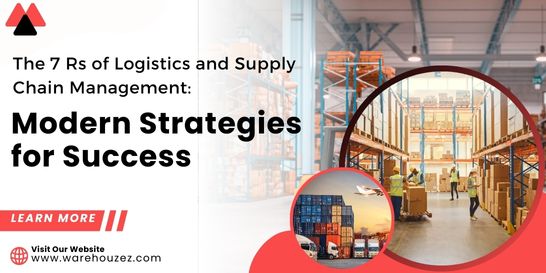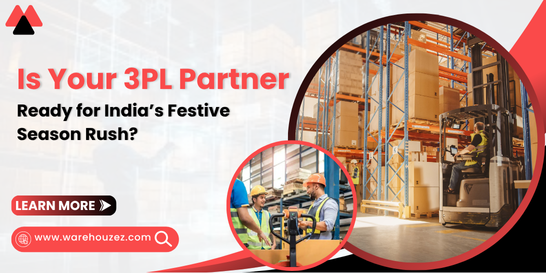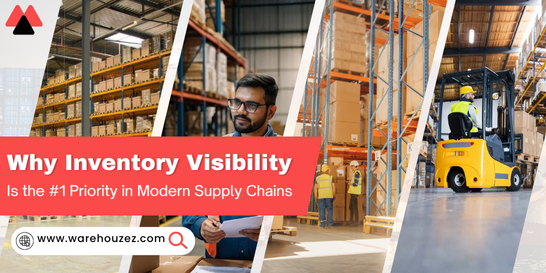The 7 Rs of Logistics and Supply Chain Management: Modern Strategies for Success
The 7 Rs of Logistics and Supply Chain Management: Modern Strategies for Success
Have you ever wondered what separates an efficient supply chain from one that constantly misses deadlines and disappoints customers? In the world of logistics and supply chain management, success is rarely accidental—it’s built on clear strategies and disciplined execution. That’s exactly where the 7 Rs of logistics come into play.
These principles are the foundation of effective operations, helping businesses move products from point A to point B with maximum efficiency, minimum cost, and exceptional customer satisfaction. But in today’s fast-changing business environment—driven by technology, e-commerce growth, and global trade—these 7 Rs often need a modern twist.
In this blog, we’ll break down the 7 Rs of logistics, share real-world examples, and explore how 3PL companies like Warehouzez apply them to deliver supply chain success.
What Are the 7 Rs of Logistics?
The 7 Rs represent a time-tested framework that guides logistics professionals in meeting customer demands efficiently. The core idea is simple: deliver the Right product, in the Right quantity, in the Right condition, to the Right place, at the Right time, for the Right customer, and at the Right cost.
This model may sound straightforward, but applying it in a fast-paced, technology-driven market requires precision, innovation, and adaptability.
Here’s the list of the 7 Rs:
1. Right Product
2. Right Quantity
3. Right Condition
4. Right Place
5. Right Time
6. Right Customer
7. Right Cost
The 7 Rs Explained with Modern Examples
1. Right Product :
Ensuring customers receive exactly what they ordered is non-negotiable. Wrong deliveries can lead to returns, lost trust, and higher operational costs.
Example: In e-commerce, AI-driven inventory tracking ensures the correct SKU is picked and packed, reducing human error.
2. Right Quantity :
Too much inventory ties up money, while too little results in missed orders.
Example: Demand forecasting tools powered by machine learning help predict sales trends, so businesses maintain optimal inventory levels year-round.
3. Right Condition :
The quality of a product upon delivery says a lot about a brand.
Example: Cold chain logistics for pharmaceuticals use IoT sensors to monitor temperature in real-time, ensuring vaccines and medicines arrive in perfect condition.
4. Right Place :
Getting products to the correct location—whether it’s a customer’s home or a retail store—is a core part of logistics success.
Example: GPS-enabled route optimization ensures drivers take the fastest, most fuel-efficient path to the delivery address.
5. Right Time :
On-time delivery isn’t just an advantage anymore—it’s expected.
Example: Same-day delivery services by giants like Amazon set the benchmark for delivery speed, forcing others to adopt advanced order fulfillment processes.
6. Right Customer :
Reaching the intended recipient is essential for both B2B and B2C deliveries.
Example: Last-mile verification systems, including OTP-based delivery confirmation, ensure that packages are handed to the correct person.
7. Right Cost :
Delivering efficiently without inflating expenses keeps businesses competitive.
Example: Consolidated shipments and automated warehouse processes reduce fuel and labor costs without affecting service quality.
Why the 7 Rs Still Matter in 2025
While technology has transformed logistics and supply chain management, the 7 Rs remain the backbone of operational excellence. In 2025, these principles are more important than ever due to:
1. Rising customer expectations for faster, more accurate deliveries.
2. Global supply chain disruptions caused by climate events, labor shortages, and geopolitical issues.
3. Increased competition in e-commerce and retail markets.
4. Sustainability goals push businesses to optimize operations and reduce waste.
The businesses that master the 7 Rs with modern tools—like AI, IoT, blockchain, and warehouse automation—will consistently outperform their competition.
How Warehouzez Applies the 7 Rs for Better Supply Chain Performance
Warehouzez, a leading Third-Party Logistics (3PL) provider, uses a combination of industry expertise and latest technology to apply the 7 Rs in every aspect of its operations.
Here’s how they do it:
1. Right Product: Uses a Warehouse Management System (WMS) with barcode scanning and real-time inventory tracking to eliminate picking errors.
2. Right Quantity: Deploys demand planning software to forecast needs, preventing overstocking and stockouts.
3. Right Condition: Maintains climate-controlled facilities for sensitive goods and follows strict handling protocols for fragile items.
4. Right Place: Operates a nationwide network of warehouses strategically located near key markets for faster distribution.
5. Right Time: Offers express shipping options and uses route optimization tools to ensure timely deliveries.
6. Right Customer: Uses delivery verification systems and integrates with CRM platforms for accurate customer data.
7. Right Cost: Leverages shared warehousing, bulk shipping, and automation to keep logistics costs competitive without compromising service.
By aligning these 7 Rs with cutting-edge technology, Warehouzez delivers efficient, reliable, and scalable 3PL warehousing solutions for businesses across multiple industries.
Concluding Remarks
The 7 Rs of logistics and supply chain management are far more than just a checklist—they are the guiding principles behind every successful delivery. In 2025, businesses that apply these principles with modern strategies will meet customer expectations, reduce costs, and achieve sustainable growth.
Whether you are an e-commerce seller, a manufacturer, or a retail giant, focusing on delivering the Right product, in the Right quantity, in the Right condition, to the Right place, at the Right time, for the Right customer, and at the Right cost is your best bet for long-term success.
With experts like Warehouzez, achieving these goals becomes not just possible, but effortless. The future of logistics belongs to those who master the 7 Rs—are you ready to be one of them?



